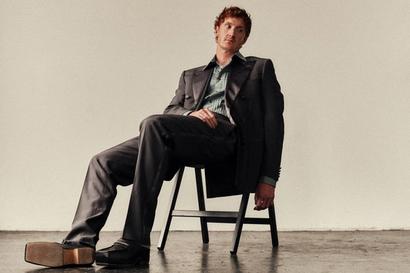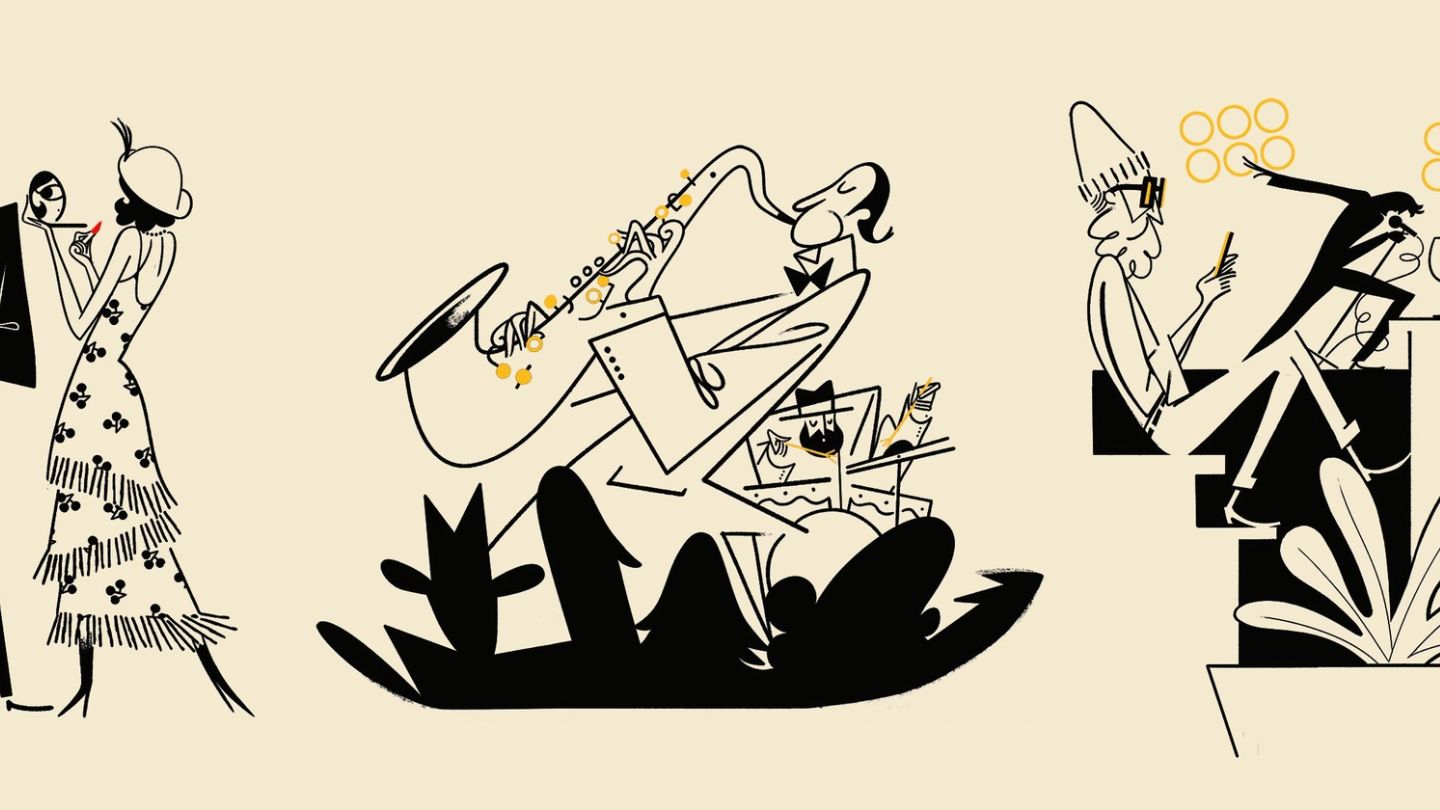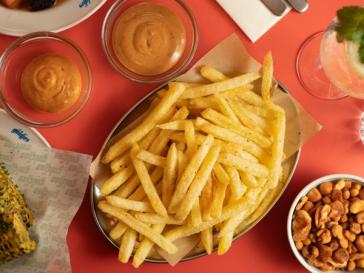

Words: Joseph Bullmore
Illustrations: Simone Massoni
To read gossip columns dialled in from the great nightclubs of the 20th century is to read dispatches from some forgotten colony. Those early reports are near electric: the mingling of maharajahs and moguls, the butterflies in the stomach, the exquisite outfitting, the counterculture and exhibitionism, the enterprise and ingenuity, the public panic and freedom — once upon a time, Mayfair and Soho buzzed and flared like neon signs in a darkened alleyway.
How the mighty have fallen. ‘Nightclub’ now is not so much a dirty word as a faintly embarrassing one — a tacky tag for oversweet cocktails, meaningless one-word names above grubby doorways and Euro kids in studded high-tops. The doorgirls are humourless, not-quite-models, while the minimum table spend (if you aren’t a name-dropping, back-of-the-loo- seat-crouching socialite who’s stuck around for enough quiet Wednesdays to ingratiate yourself with the fifty- something bachelor owner) is pegged to a month’s rent (plus utilities) in the neighbouring suburb.
To go ‘out out’ you’ll need a cloak of knowing irony and a desperate lack of alternatives (a dinner party, a house party, a club membership, a restaurant corner booth, a Netflix account, a cousin’s bar mitzvah, a third cousin’s wake). To stay out you better have a willingness to wait in an inexplicable queue (there’s no one inside) and a working knowledge of Love Island contestants from before Love Island got good.
I write this from a place of love, you understand. It certainly isn’t meant to sound superior (well, only slightly). Nightclubs, in their own way, are cultural institutions — as formative to the flavour and history of London as any museum or restaurant. When the Blitz thundered down on the capital, it wasn’t to the Tate or the Ritz or the British Museum that the upper crusters flocked — it was to the Café de Paris. Sure, the subterranean location helped. But so did the louche defiance of it all. Drop your bombs all you like, Herr Göring — we’ve got some light flirting to be getting on with.
Nightclubs were a second home to both the beau monde and the low life; places of intrigue and riotous behaviour.
This says a lot about Londoners, but it says more about nightclubs. These were places you went to spend your last night on earth, back when there was a very real chance that it might be. They were a second home to both the beau monde and the low life; miniature republics beyond conventional jurisdiction; international waters below the puddles of Grosvenor Square. More than this, they were places of intrigue, creativity and riotous behaviour, where the task at hand was the most serious of all: having fun. And it didn’t much matter who you were, either. Every slice of society had its fondant filling.
The Cave of the Golden Calf, located beneath Heddon Street in Mayfair, was almost certainly the first gay bar in modern history. It opened in 1912, at a time when homosexuality was officially considered both an abomination and an impossibility. “Down a dark cul-de-sac lurked a new and devilish sort of place where Futurists cavorted,” wrote Philip Hoare about the place in his book Oscar Wilde’s Last Stand. “Eric Gill designed the club’s motif, a phallic Golden Calf, symbol of biblical dissipation and idolatry,” while the founders’ own stated aim was to create “a place given up to gaiety” — a hideout “brazenly expressive of the libertarian pleasure principle.” Dissipation! Idolatry! Pleasure! These are not words easily applied to Edwardian England.
The Golden Calf shut down in 1914, but others followed in its bubbling wake. The 50-50, run by matinee darling Ivor Novello, was said to cater exclusively to ‘Us’ (with a capital ‘U’), which meant either ‘theatre people’ or ‘gay people’, depending on who was asking. (The name itself referred to Novello’s omnivorous sexuality.)
At the Hambone, a 20s flappers’ paradise located at the site of the new Ham Yard Hotel, conventions were flouted almost for sport. The club was a breeding ground for extramarital affairs of every flavour and a cauldron of homosexual promiscuity. Unaccompanied women danced among the lipstick-sporting, crème-de-menthe-sipping young male aristocrats — and they were just as interested in the showgirls as anybody else.
Ethel Mannin’s 1925 novel Sounding Brass makes a veiled reference to the Hambone’s famously androgynous performers — one pianist is described as “either a masculine woman or a feminine man.” Down at the Running Horse in Mayfair, meanwhile, the police kept a close eye on the to-ers and fro-ers of this new set. One surveillance report from 1936 records “three women of masculine appearance. Their hair cut short in manly fashion, they wore costumes of collars and ties and no hats.”
In the nightclub, even if only for a few hours, women had the upper hand.
Despite the near- constant attention of the police, for the majority of the 20th century the nightclub remained a sanctuary largely beyond the reach of the law. Their underground locations mirrored clandestine intentions — and once inside, all bets were off. Behaviour that would have you locked up above ground saw you applauded below it. The socialite Stephen Tennant, for example — once dubbed “the brightest of the Bright Young Things” — was indulged in the press throughout the 20s despite his overt homosexuality. His wild-dancing, cheek-kissing habits marked him out as a figure of intrigue instead of a target of hate. This is progress of a kind.
Nightclubs often stretched the conventional class order to its breaking point. Members of parliament and minor royals could now swan happily about with gun runners and prostitutes. The Blue Lantern, around the corner from Ham Yard in Soho, was a scrum of Old Etonians and East End mobsters. Its neighbouring club, the New Avenue, changed its name to the ‘Havinoo’ in homage to the way that Cockney thugs would affect an upper-class accent to pronounce the word.
Henry Degras, a former patron of the Falstaff in Oxford Street, remembers in his memoir Low Company how “women for 10 shillings a bet walked naked through the rooms. And on the dancefloor, men lifted the skirts of girls as they passed and smacked their bare buttocks.” (Needless to say, the club was a favourite among both Establishment figures and Soho gangsters.) The district’s early nightclubs were a promised land of social mobility, too, and long before the second world war stepped in as the great class leveller.
Kate ‘Ma’ Meyrick — whose venue, the 43 Club on Gerrard Street, was raided five times before it was closed in 1928 — claimed she’d made half a million pounds through the club in its short lifetime. All of her children attended expensive public schools alongside the heirs of the politicians who had tried to shut her down. (Her daughter Dorothy even married Edward Russell, the 26th Baron de Clifford.)
The feminist movement danced to a similar beat. A letter written to the Daily Express in 1920 sums up the moral panic at the rise of the nightclub and the new freedom it permitted to women: “The majority of men prefer a girl of modest disposition,” it concluded. “That is, one who does not smoke, flirt or jazz.” And there was nowhere better for a woman to smoke, flirt or jazz than in a nightclub.
In the inter-war period this raucous energy was defined by the image of the flapper: a shorter-haired, higher-hemmed, utterly self confident young girl who didn’t need to be invited by a gentleman with a dance card to take centre stage. The biggest band leader of the time was perhaps Ivy Benson, the face of the Ivy Benson All Girl Orchestra. She found her success on the dance hall circuit, and had soon spawned a litter of all-female orchestra imitators.
By the time the second world war rumbled around, a phrase in common currency showed just how far things had come. ‘Yank hunting’ was the practice, among ‘uninhibited’ women, of seeking out and seducing American GIs in the dance halls of London. In the nightclub, even if only for a few hours, women had the upper hand.
‘At one point we had three James Bonds having dinner at the same time,’” says Claudio, the head waiter at Tramp. ‘Just by accident.’
The denizens of clubland were the outriders of each decade, mapping its terrain before the mainstream could catch up. Nightclubs are better guides to history than any academic text. Most decades don’t show their true colours till two in the morning. The 50s, that era of returning optimism and the birth of youth culture, is neatly summed up by the image of Princess Margaret escaping Clarence House in her beau Billy Wallace’s bubble car to go dancing until the small hours. (The destination was more often than not The 400, a basement club in Leicester Square that was decreed “the night-time headquarters of society.”)
The nation’s new obsession with Americana, meanwhile, was assured by the emergence of the invincible Ronnie Scott’s and Les Ambassadeurs, on Hamilton Place in Mayfair, where Yanks like Benny Goodman, Ella Fitzgerald and Billie Holiday often held court.
The swinging 60s, with all their counter-culture and hallucinogenic abandon, were hot-housed in the Carnaby Street musical clubs and Soho’s basements and attics. Sybilla’s, perhaps the most wildly anticipated opening of the decade, gained a great deal of its fizz from the rumour that George Harrison was a founder. Even at the old-guard foxhole Annabel’s (a former coal cellar below the Clermont Club premises on Berkeley Square with decor designed to mimic an eccentric aristocrat’s downstairs loo) it was Mick Jagger and Keith Richards who attracted the flashbulbs — forget the Queen (who visited one night in 2003).
The Ad Lib, in Leicester Square, was the club where John Lennon and George Harrison accidentally had their first acid trip — their coffees were spiked while they were having dinner in Bayswater. Siegi’s Club (on the site of the now-Mark’s Club on Charles Street in Mayfair) was a perfect portrait of early 60s London and its new celebrity culture. Frank Sinatra, Humphrey Bogart and Clark Gable were all regulars, while founder Siegi Sessler’s brother Freddie was the Rolling Stone’s de facto pharmacist — he would trot around Mayfair from party to party with milk bottles filled to the brim with pharmaceutical cocaine, fresh from the laboratories at Mallinckrodt and Merck. Simpler times.
Next came the recession-dodging optimism of the 70s, where trattorias- turned-clubs such as dell’Aretusia on the King’s Road signalled a new relaxed and continental atmosphere in London, away from drizzly cuisine and white tablecloths. Tramp and Regine’s were big players, too — the latter challenged even Studio 54 for supremacy in the excess stakes. Andy Warhol, Princess Caroline of Monaco and Jack Nicholson were all regulars, and party-goers described it as “an addictive pleasure palace” where “cocaine spilled over the tables”.
Tramp, down on Jermyn Street, was a glitzy, spritzy affair, often ankle-deep in champagne — Peter Sellers, Joan Collins, Liza Minnelli and Ringo Starr all had their wedding receptions at the club, while 70s super-group the Small Faces were part of the velveteen furniture. (“At one point we had three James Bonds having dinner at the same time,” says Claudio, Tramp’s longstanding head waiter. “Sean Connery, George Lazenby and Roger Moore. Just by accident.”)
Eighties clubland, meanwhile, was alive with the entrepreneurial spirit of privatisation: Richard Branson is said to have bought Kensington Roof Gardens (then home to Regine’s) in 1981 after he was turned away at the door for being too scruffy. Then came the Sloane Rangers in the middle of the decade — that odd, toffy tribe who snuck their Gucci loafers under any table they could in order to find a suitable wife. (Embassy in Old Bond Street was said to have been killed off by the invasion of Sloanes trying to get off with their friends’ pearl-necklaced sisters.)
The birth of British rave culture, meanwhile, can be pinned to Shoom, a tiny sweatbox that kicked off in 1987 in deepest Southwark. When it died after two years, because the corporates tried to take over, rave withered with it. I’m sure there’s a metaphor for Thatcherism in there.
Even recent decades come alive under neon lights. There’s no scene more painfully 90s than Davina McCall pouring alcopops for Kylie Minogue at Subteranea under the Westway. The pre-recession arrogance of the noughties is pretty well summed up by the bad trousers, floppy hair and Daily Mail-headlines-in-the-making over at Boujis in South Kensington, or the desperate throng outside Bodo’s Schloss come Thursday night. (The early legend went that Prince Harry had built a tunnel from Kensington Palace to the Bodo’s back room).
These weren’t high points, of course, but at least they were memorable. It makes you wonder what it says about our own decade that the offering in clubland now is so dismal, so slight, so derivative and so self-regarding.
The story goes that Richard Branson bought Kensington Roof Gardens in 1981 after he had been turned away at the door for being too scruffy.
It’s hard to know when the rot set in. Mark Fuller, the nightclub impresario who ran Embassy in the 80s, pins the time to some point roughly about a decade ago. The culprit is the same as in every cultural decline: cash. “Minimum spends on tables came in and it became a serious money industry,” he told the Evening Standard in 2016. “That was the beginning of our demise. For the price of a night out in Movida or Chinawhite, you could buy yourself a luxury car. The costs were exorbitant. It was like Harry Enfield’s character Loadsamoney,” he says.
Worse still, promoters began paying ‘celebrities’ to stand around in their clubs — a far cry from the heyday at Siegi’s, say, where even Cary Grant was expected to settle his tab. “I know nightclubs that have taken £80,000 in a night and still lost money,” Fuller sobbed. “We killed ourselves. We killed our own industry.”
Really, this should have been obvious. The great nightclubs of the 20th century saw cash as a happy side- effect, not as a raison d’etre. (And don’t you find that all that talk of payment upfront slightly ruins the fun?) Like oil and water, money and parties don’t mix — try bringing up your salary at your next mixer, and see just how quickly the atmosphere gets chilly. I’m sure the cameraphone also has something to do with it, not to mention the slew of dating apps that offer dopamine and companionship without the need to leave your sofa.
Then, of course, there’s the new social supremacy of the restaurant, which, actually, seems to closely mirror the early nightclubs in terms of entertainment and enterprise. Or perhaps things just ran their course. “The thrill has gone/ to linger on/ might spoil it anyhow,” sang Noel Coward in 1932. “Let’s creep away from the day/ for the party’s over now.” Let’s not linger, shall we?
When the Hambone shut in 1929, it sent a short poem out to its members — a swansong to itself, to its bohemian clientele, to the decade at large: “Oh! We are the great Progressives, we are the Passionate Few. We pay ninepence for fourpence lagers, and dream of the things we’ll do!”’ Such optimism now seems grossly misplaced.
This feature first appeared in our March issue, click here to subscribe and get your copy sent to your door today…


